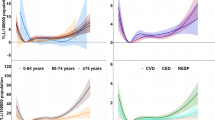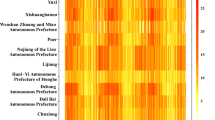Abstract
Several studies have investigated the associations between diurnal temperature rage (DTR) and mortality, but little evidence has been available regarding the association of DTR with years of life lost (YLL). The aim of this study was to examine the association of DTR with YLL rate, and quantify life loss per death caused by DTR in China. Daily meteorological and death data were collected from 364 locations in China during 2006–2017. First, we calculated daily YLL rate. Then, the distributed lag nonlinear model was applied to estimate the associations of DTR with YLL rate in each location, and multivariable meta-analysis was conducted to pool the location-specific estimates. Finally, we calculated the attributable fractions of DTR on YLL rate and average life loss per death to estimate the mortality burden caused by DTR. Subgroups analyses were conducted by region, age, sex and cause of death. A J-shaped association of DTR with YLL rate was identified in China. The minimum YLL-rate DTR (MYDTR) was 3.7 °C nationwide. The overall AF of DTR in China was 6.40% [95% confidence interval (CI) 3.95–8.86%], and AFs caused by DTR were higher in females, the elderly and south China. An average of 0.96 years (95%CI 0.57–1.35) life loss per death was attributable to DTR nationwide, and life losses per death attributed to DTR were higher in female, young population, and south China. AF and life loss per death caused by DTR were much higher in cold season than that in warm season. Both high DTR and low DTR increased YLL rate in China. Mortality burdens of DTR were much higher in cold season than warm season. The effects of DTR were modified by region, demography and cause of death. Our findings suggest that vulnerable population should be protected when daily temperature change rapidly, especially in cold season.


Similar content being viewed by others
Data availability
If need data, please contact with corresponding author.
Code availability
If need code, please contact with corresponding author.
References
Bull GM (1980) The weather and deaths from pneumonia. Lancet 1:1405–1408. https://doi.org/10.1016/s0140-6736(80)92666-5
Chen R et al (2018) Association between ambient temperature and mortality risk and burden: time series study in 272 main Chinese cities. BMJ 363:k4306. https://doi.org/10.1136/bmj.k4306
DALYs GBD, Collaborators H (2017) Global, regional, and national disability-adjusted life-years (DALYs) for 333 diseases and injuries and healthy life expectancy (HALE) for 195 countries and territories, 1990–2016: a systematic analysis for the global burden of disease study 206. Lancet 390:1260–1344. https://doi.org/10.1016/S0140-6736(17)32130-X
Gardner JW, Sanborn JS (1990) Years of potential life lost (YPLL)–what does it measure? Epidemiology 1:322–329. https://doi.org/10.1097/00001648-199007000-00012
Gasparrini A, Armstrong B, Kenward MG (2010) Distributed lag non-linear models. Stat Med 29:2224–2234. https://doi.org/10.1002/sim.3940
Gasparrini A et al (2015) Mortality risk attributable to high and low ambient temperature: a multicountry observational study. Lancet 386:369–375. https://doi.org/10.1016/S0140-6736(14)62114-0
Graudenz GS, Landgraf RG, Jancar S, Tribess A, Fonseca SG, Fae KC, Kalil J (2006) The role of allergic rhinitis in nasal responses to sudden temperature changes. J Allergy Clin Immunol 118:1126–1132. https://doi.org/10.1016/j.jaci.2006.07.005
Guo Y et al (2014) Global variation in the effects of ambient temperature on mortality: a systematic evaluation. Epidemiology 25:781–789. https://doi.org/10.1097/EDE.0000000000000165
Guo Y et al (2016) Temperature variability and mortality: a multi-country study. Environ Health Perspect 124:1554–1559. https://doi.org/10.1289/EHP149
Huang C, Barnett AG, Wang X, Tong S (2012) Effects of Extreme Temperatures on Years of Life Lost for Cardiovascular Deaths: A Time Series Study in Brisbane, Australia. Circ Cardiovasc Qual Outcomes 5:609–614. https://doi.org/10.1161/circoutcomes.112.965707
Kan H et al (2007) Diurnal temperature range and daily mortality in Shanghai, China. Environ Res 103:424–431. https://doi.org/10.1016/j.envres.2006.11.009
Keatinge WR, Coleshaw SR, Cotter F, Mattock M, Murphy M, Chelliah R (1984) Increases in platelet and red cell counts, blood viscosity, and arterial pressure during mild surface cooling: factors in mortality from coronary and cerebral thrombosis in winter. Br Med J (Clin Res Ed) 289:1405–1408. https://doi.org/10.1136/bmj.289.6456.1405
Kim J et al (2016) Comprehensive approach to understand the association between diurnal temperature range and mortality in East Asia. Sci Total Environ 539:313–321. https://doi.org/10.1016/j.scitotenv.2015.08.134
Lee WH et al (2017) An investigation on attributes of ambient temperature and diurnal temperature range on mortality in five East-Asian countries. Sci Rep 7:10207. https://doi.org/10.1038/s41598-017-10433-8
Lim YH, Park AK, Kim H (2012) Modifiers of diurnal temperature range and mortality association in six Korean cities. Int J Biometeorol 56:33–42. https://doi.org/10.1007/s00484-010-0395-0
Lim YH, Reid CE, Mann JK, Jerrett M, Kim H (2015) Diurnal temperature range and short-term mortality in large US communities. Int J Biometeorol 59:1311–1319. https://doi.org/10.1007/s00484-014-0941-2
Lozano R et al (2012) Global and regional mortality from 235 causes of death for 20 age groups in 1990 and 2010: a systematic analysis for the global burden of disease study 2010. Lancet 380:2095–2128. https://doi.org/10.1016/S0140-6736(12)61728-0
Luo Y et al (2013) Lagged effect of diurnal temperature range on mortality in a subtropical megacity of China. PLoS ONE 8:e55280. https://doi.org/10.1371/journal.pone.0055280
Ma W et al (2015) The temperature-mortality relationship in China: an analysis from 66 Chinese communities. Environ Res 137:72–77. https://doi.org/10.1016/j.envres.2014.11.016
Majdan M et al (2017) Years of life lost due to traumatic brain injury in Europe: a cross-sectional analysis of 16 countries. PLoS Med 14:e1002331. https://doi.org/10.1371/journal.pmed.1002331
Makowski K, Wild M, Ohmura A (2008) Diurnal temperature range over Europe between 1950 and 2005. Atmos Chem Phys 8:6483–6498. https://doi.org/10.5194/acp-8-6483-2008
Murray CJL et al (2012) Disability-adjusted life years (DALYs) for 291 diseases and injuries in 21 regions, 1990–2010: a systematic analysis for the global burden of disease study 2010. The Lancet 380:2197–2223. https://doi.org/10.1016/s0140-6736(12)61689-4
Odhiambo Sewe M et al (2018) Estimated Effect of temperature on years of life lost: a retrospective time-series study of low- middle-, and high-income regions. Environ Health Perspect 126:017004. https://doi.org/10.1289/EHP1745
Steenland K, Armstrong B (2006) An Overview of methods for calculating the burden of disease due to specific risk factors. Epidemiology 17:512–519. https://doi.org/10.1097/01.ede.0000229155.05644.43
Thiam A, Zhao Z, Quinn C, Barber B (2016) Years of life lost due to metastatic melanoma in 12 countries. J Med Econ 19:259–264. https://doi.org/10.3111/13696998.2015.1115764
Xiao J et al (2015) How much does latitude modify temperature-mortality relationship in 13 eastern US cities? Int J Biometeorol 59:365–372. https://doi.org/10.1007/s00484-014-0848-y
Yang J et al (2013) Global climate change: impact of diurnal temperature range on mortality in Guangzhou. China Environ Pollut 175:131–136. https://doi.org/10.1016/j.envpol.2012.12.021
Yu W, Mengersen K, Wang X, Ye X, Guo Y, Pan X, Tong S (2012) Daily average temperature and mortality among the elderly: a meta-analysis and systematic review of epidemiological evidence. Int J Biometeorol 56:569–581. https://doi.org/10.1007/s00484-011-0497-3
Zhang Y, Yu C, Yang J, Zhang L, Cui F (2017b) Diurnal temperature range in relation to daily mortality and years of life lost in Wuhan, China. Int J Environ Res Public Health. https://doi.org/10.3390/ijerph14080891
Zhang Y, Yu C, Bao J, Li X (2017a) Impact of temperature variation on mortality: an observational study from 12 counties across Hubei Province in China. Sci Total Environ 587–588:196–203. https://doi.org/10.1016/j.scitotenv.2017.02.117
Zhang Y, Peng M, Wang L, Yu C (2018) Association of diurnal temperature range with daily mortality in England and Wales: a nationwide time-series study. Sci Total Environ 619–620:291–300. https://doi.org/10.1016/j.scitotenv.2017.11.056
Zhou M et al (2016) Cause-specific mortality for 240 causes in China during 1990–2013: a systematic subnational analysis for the global burden of disease study 2013. The Lancet 387:251–272. https://doi.org/10.1016/s0140-6736(15)00551-6
Acknowledgements
This work was supported by the National Key Research and Development Program of China (2018YFA0606200), Guangzhou Science and Technology Project (201704020194), Natural Science Foundation of Guangdong, China (2019A1515011880), and Guangdong Health Innovation Platform.
Funding
This work was supported by the National Key Research and Development Program of China (2018YFA0606200), Guangzhou Science and Technology Project (201704020194), Natural Science Foundation of Guangdong, China (2019A1515011880), and Guangdong Health Innovation Platform.
Author information
Authors and Affiliations
Corresponding author
Ethics declarations
Conflicts of interest
The authors declare no competing financial interest.
Additional information
Publisher's Note
Springer Nature remains neutral with regard to jurisdictional claims in published maps and institutional affiliations.
Supplementary Information
Below is the link to the electronic supplementary material.
Rights and permissions
About this article
Cite this article
Cai, M., Hu, J., Zhou, C. et al. Mortality burden caused by diurnal temperature range: a nationwide time-series study in 364 Chinese locations. Stoch Environ Res Risk Assess 35, 1605–1614 (2021). https://doi.org/10.1007/s00477-021-02016-x
Accepted:
Published:
Issue Date:
DOI: https://doi.org/10.1007/s00477-021-02016-x




